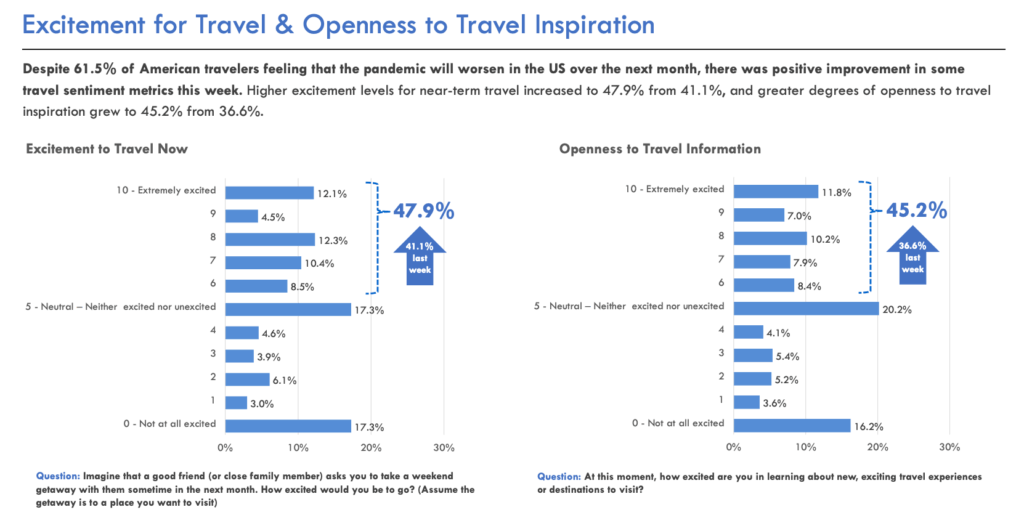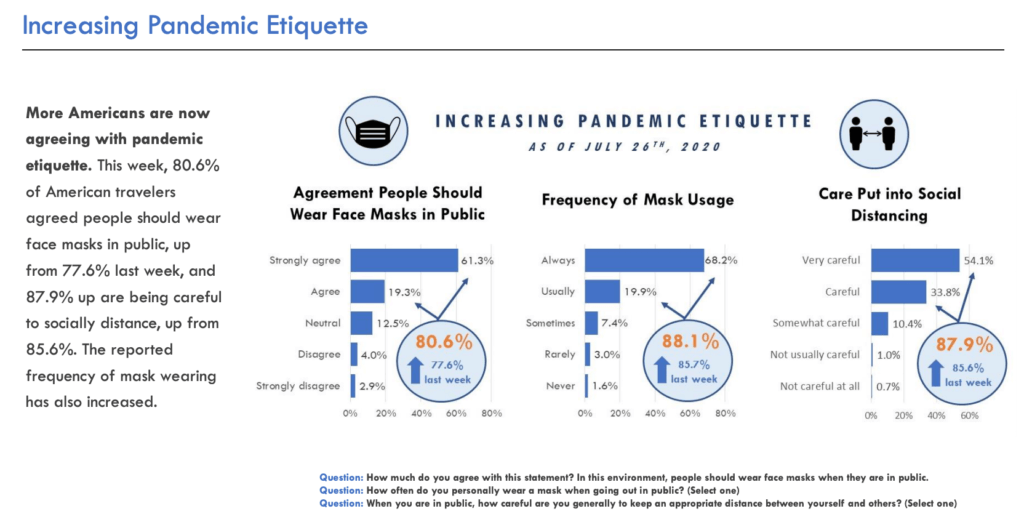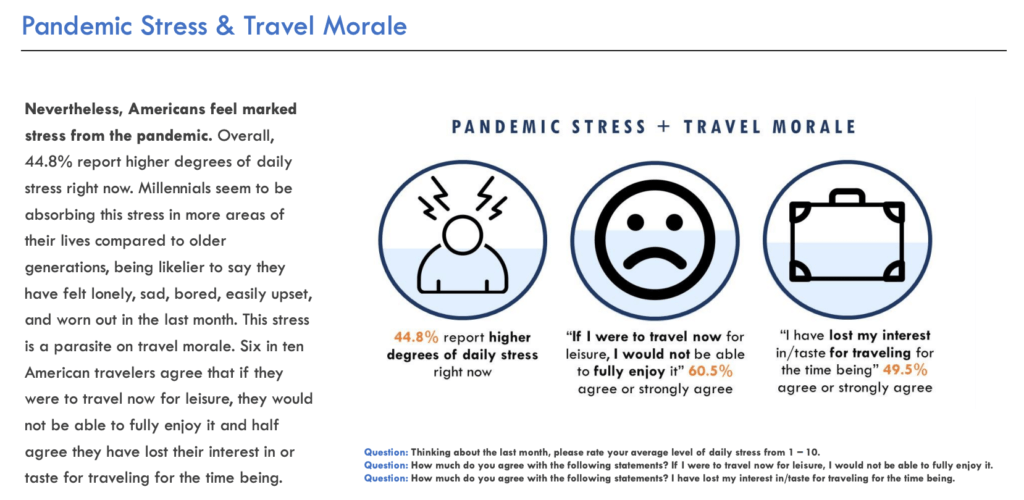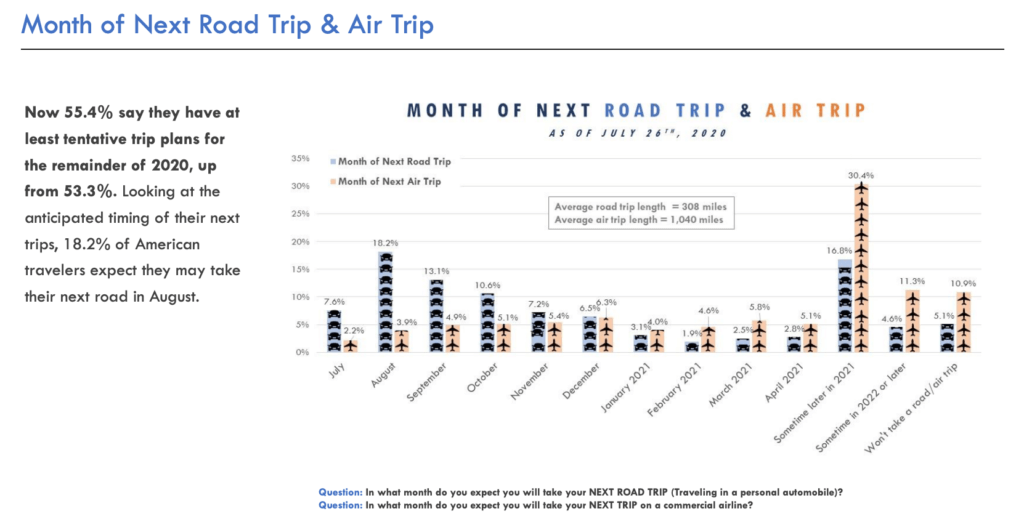DMO INSIGHTS – JULY 28
- Jul 28, 2020
- By Justin Yax
- In DESTINATION, DMO INSIGHTS
In this edition:
- – LATEST RESEARCH FINDINGS FROM DESTINATION ANALYSTS
- – RESUMING MEDIA AND INFLUENCER VISITS
- – HOSPITALITY INDUSTRY – STAYING SAFE OUTSIDE OF WORK
- – THE ONLY CONSTANT IN LIFE IS CHANGE
- – MESSAGING FOR LOCALS & VISITORS – A CROWDRIFF LIVE Q&A
- – RECENT NEWS & USEFUL LINKS
This weekend I finally ate in a restaurant for the first time since early March. Well not actually in the restaurant – though many people seemed comfortable sitting in the dining room – but on their outdoor patio. I guess that makes me part of the “wait and see” audience who wanted to let the early adopters go first. Or maybe I’m just being too cautious, if there is such a thing right now. Either way, the decision still wasn’t easy. But I had grown tired of my own cooking, become desensitized to my fears, and I just really wanted some good Mexican food.
The thought of eating at a restaurant seemed almost unheard of to me just one month ago. At the same time, my wife and I sent our son back to full-time preschool three weeks ago when his Montessori school was allowed to reopen, albeit with numerous restrictions.
Something I have learned through all of this – and it applies to everything from dining and travel to grocery shopping and going to playgrounds – is that everyone approaches every situation with different levels of caution. We all have our own levels of comfort, and we’re all on our own timeline. And that’s okay.
Thanks, as always, for reading, and we hope you continue to find value in this newsletter.
DESTINATION ANALYSTS’ WEEKLY SURVEY FINDINGS
Signs of improving traveler sentiment and pandemic etiquette showed up in this week’s survey findings from Destination Analysts (PDF available HERE). At the same time, pandemic induced stress, travel enjoyment, and travel morale appear to be suffering as COVID wears on.
Travel excitement grows: Excitement for travel and openness to travel information both jumped this week, up 6.8% and 8.6% respectively. Now, more than 65% of travelers are neutral or better when it comes to their excitement to travel over the next month, and 65.4% are neutral or better with regard to learning about new travel experiences or destinations to visit. Looking at the number of people who answered “not at all excited,” to either question, it appears travel largely remains an either/or option for people right now. Either you’re excited or you aren’t, and there isn’t much middle ground.

Mask wearing & social distancing improve: As mask mandates expand, and as the use of face coverings becomes less stigmatized and an increasingly normalized behavior, it’s not surprising that perceptions and compliance are both up this week. What is a little surprising, though, is that social distancing practices are also up. Often an increase in one of these behaviors (face coverings or social distancing) leads to a decrease in the other. But we’re seeing increases in both behaviors, which is a good sign that people are once again taking their safety and the safety of others seriously. Though my wife did witness a confrontation on a popular bike path this weekend that culminated with a masked walker confronting a group of unmasked bike riders with, “put some $!#&ing masks on or go the $!#& home!”

The stress & travel chain reaction: Who isn’t feeling a little extra stress these days? If you’re like 44.8% of respondents, you have a higher degree of daily stress right now. It’s even stressing me out to think about the 55.2% of people who lied and said they weren’t feeling more stress right now than a month ago. Among those reporting the highest incidence of stress are Millennials, who not surprisingly also tend to be in the most extroverted life stage. This increased stress among Americans has a trickle-down effect on travel that plays out as follows: I am more stressed (44.8%). If I were to travel, I wouldn’t enjoy it as much as a result (60.5%). Therefore, I have lost my interest in traveling for the time being (49.5%).

Just how friendly are the friendly skies?: According to the 11.3% of respondents who have recently traveled by air, the friendly skies are actually pretty friendly these days. Almost three quarters (74.8%) of recent air travelers said they were satisfied (40.7%) or very satisfied (34.1%) with airline coronavirus safety protocols during their most recent flight, and a similar percentage (73%) felt the same about airports during their most recent flight. Airlines and airports have gone to great lengths to increase cleaning and safety protocols, and among the few who are traveling by plane, these efforts seem to be evident.

Air travel still lags behind: Despite the increases in safety protocols referenced above, air travel still appears to be near the bottom of peoples’ preferred modes of transportation right now. According to the survey, air travel will continue to lag well behind automobiles through the end of the year and will track slightly higher through the winter. It isn’t until April 2021 and beyond when air travel appears to see demand return at any meaningful level. Or, this may be another case of letting the ‘early adopters’ be the current test subjects, with the ‘proof of concept’ and ‘wait and see’ audiences following soon after.

Back To Top
RESUMING MEDIA AND INFLUENCER VISITS
This week, we hosted a trio of media and influencers including a writer who helped Ariana Huffington found Huffington Post, an influencer who also happens to be Yanni’s daughter, and a photographer who accompanied them. We are in the process of actively planning another half dozen or so media visits over the next 2-3 weeks. And just yesterday we received an email that read in part, “We are starting to publish travel articles again and are looking for destinations and properties open to hosting media.”
There’s no question that following a four month hiatus, and with a few notable exceptions such as states with mandatory quarantines or other travel restrictions, the opportunity to host media, influencers, and bloggers has returned.
I was talking with the West Coast Editor of Conde Nast Traveler last week related to a story she is writing about destinations that have implemented visitor “pledges” or similar programs intended to help alleviate health and safety concerns among travelers. Not surprisingly, she told me that one of the most challenging aspects of her job during the pandemic has been finding new and unique ways to write about travel without actually traveling.
Throughout this pandemic, we have been maintaining regular communication with a core audience of media and influencers to keep them abreast of the situation in the various destinations we represent, provide timely and unique story ideas, remain top-of-mind for their current and future needs, and to remind them that once they were ready to travel again, they only needed to make one call. Based on the interest we are seeing from media and influencers looking to resume their travels, I believe that approach and investment is just now really starting to pay off.
Whether or not your destination is actively recruiting media and influencer visits, there are a few important elements to consider when doing so:
Prioritize drive markets: This likely goes without saying, but an emphasis on generating media visits from drive markets will likely yield the highest return on investment right now and for the foreseeable future. Consider expanding your efforts to markets within an 8-10 hour drive radius, as Americans are willing to drive further than usual for the safety of traveling in their own vehicle.
Plant seeds for flight markets: Just because people aren’t flying, or flight schedules to your airport have been temporarily reduced, does not mean you can or should avoid targeting those markets. Investing the time and resources now will pay dividends down the road.
Target niche audiences: There’s a big difference between drinking wine and visiting wine country. RV travel and van life are seeing huge increases in interest and participation. Private pilots have the ability to travel greater distances by air without compromising safety. Family travel will continue into fall as ‘Roadschooling’ starts trending. And everyone could use a little extra wellness in their life right now. These are just a few of the many trends that represent opportunities for destinations to target specific media and influencers whose niches align with yours.
Instant and delayed gratification: While public relations is most often a long-term play, there is a greater need to utilize PR to generate awareness and coverage right now. As such, a combination of instant gratification (social media, bloggers, broadcast, and digital/online) and delayed gratification (magazines, newspaper features) will allow destinations to demonstrate an immediate ROI while waiting for the long-term payout of larger feature coverage.
Don’t sugarcoat things: If ever there was a time to underpromise and overdeliver, now is that time. As an agency, we would rather be honest and transparent and miss out on the opportunity to host a writer or influencer, as opposed to misrepresenting a destination and risking backlash from having the experience differ greatly from the expectation.
Pay it forward: We often ask tourism partners within destinations to provide in-kind products and services as part of the broader itinerary for media and influencer visits. That’s an easier pill to swallow for some than for others, particularly right now. Being mindful of that, asking for a media rate as opposed to a comp, or offering to pick up a portion if not all of the tab will not only demonstrate a commitment to your tourism partners’ success, it will build long-term trust and equity with them as well.
Back To Top
HOSPITALITY INDUSTRY – STAYING SAFE OUTSIDE OF WORK
Hospitality industry-affiliated businesses – particularly restaurants, hotels, bars, breweries, wineries, distilleries, attractions, and boutiques – are doing everything they can just to stay open and generate much needed revenue right now. If they are even allowed to operate at all, as is the case with many bars and restaurants that have been forced to close or greatly alter their operations.
Having an employee test positive for COVID-19, as many businesses have already found out the hard way, creates a ripple effect that can reverberate throughout a community severely and quickly.
Not only does it take a health toll on the infected individual, it taxes the broader system by triggering contact tracing, requiring others to be tested and to quarantine, and business shutdowns for an extended period of time. Further compounding the issue is the fact that many service industry workers hold more than one job, and a positive test could and likely would impact multiple businesses.
While not 100 percent avoidable, instances of employees bringing COVID-19 into the workplace from outside are a good reminder that an ounce of prevention is worth a pound of cure.
Although it still is not entirely clear in many places, the steps for what to do once an employee tests positive are more clearly defined. But what about the steps that can be taken before a positive test is ever received?
DMOs should make it a point in their ongoing communication with members and tourism partners to discuss what employers can do to help minimize this risk before it happens. This can be as simple as a friendly reminder for them to continuously inform and educate staff about practicing safe and responsible social behaviors outside of work. Many, if not most employers are already doing this, but the importance of continuing to communicate this to staff cannot be overstated.
These employees are at the front lines of keeping other team members, customers, and businesses safe, healthy, and open. Without their efforts and sacrifices, many local businesses simply wouldn’t be able to operate right now. That responsibility continues when they are “off the clock,” and are put into situations that may increase their risk of exposure due to social behaviors outside of work.
This largely involves encouraging staff to avoid situations such as social gatherings where physical distancing isn’t possible, but also extends to the CDC’s How to Protect Yourself & Others guidance including wearing a face covering, maintaining social and physical distance, frequent hand washing, and staying home from work if you show any signs of illness.
By encouraging employers to make it a habit to include these reminders in pre-shift or other team meetings and communications, you can help lower the risk of having an employee introduce COVID-19 into the workplace, and the resulting toll it takes on everyone.
Back To Top
THE ONLY CONSTANT IN LIFE IS CHANGE
The rules and regulations related to COVID-19 recovery seem to change almost daily for destinations and their constituents. Amidst restrictions that seem to ebb and flow with county, state, and national case numbers, it seems as though the only constant in life these days is change.
As an agency that works with destinations across five western states including California, Oregon, Washington, Idaho, and Montana, it can be difficult to keep track of what county let alone what state is in what phase, where case numbers are increasing or decreasing (which is easier now when cases are generally increasing across the board), restrictions on indoor vs. outdoor business operations, face covering and other mandates, allowable gathering sizes, travel restrictions and advisories, and many more variables.
The amount of information we have consumed over the past four months might be enough to fill a hall at the Library of Congress. If it were open. It’s our job to take in all of the information available to us, sift through and distill it, and develop meaningful and actionable marketing recommendations during the most critical of times. Somewhere along the way, all of this information overload has made us, by default, an authority on the subject of marketing destinations through a pandemic.
What we have learned, and what we are working hard to apply, is this very principle that the only constant in life, indeed, is change. And the better prepared we are – and by we I mean the destinations we represent – the more successful “we” will be when those inevitable changes come.
And when change is constant, it is paramount, as most destinations are finding out firsthand, to be nimble. Nimble happens to be one of our agency’s core philosophies, which is both a testament to the all-senior staff we employ as well as our approach to planning, executing, and adapting marketing strategies quickly and efficiently. In the current climate, and as it pertains specifically to destinations, nimble refers largely to the following:
Forming short-, mid-, and long-range recovery plans with the ability to expedite or delay tactics as conditions and restrictions warrant.
Planning and committing to campaigns on very short terms, and being prepared to quickly pivot and make weekly or even daily changes to align with changing regulations.
Developing situation-specific messaging, visuals, and other assets such as portraying masked employees and visitors in imagery, as well as representing diversity and people of color in creative.
More frequent if not ongoing monitoring and optimization of campaign performance across digital and social media platforms.
Communicating all of the above, plus other timely information, to members, constituents, public officials, and tourism partners on at least a weekly basis.
In addition to adapting to current changes as they happen, we can also expect to see many long-term changes as a result of COVID-19. Much like school shootings have forever changed the environment in which our children learn, this pandemic will forever change human and traveler behavior, and the ways and the extent to which our nation responds to future pandemics and other global health threats.
While we are still dealing with the first phase of the first wave of the virus, and the situation will continue to change with regard to the current threat and related restrictions, we can assure you that public officials and health experts will want to take every precaution to avoid a similar outcome in the future.
As a result, we can expect to see permanent changes that will be implemented at the first sign of future health emergencies. These changes may include preemptive face covering mandates, more frequent and shorter-term incidences of stay-at-home orders, short-term closures of public spaces, greater restrictions on public and social gatherings, and more. Not only are these and other tactics likely to become more commonplace in our future, we can also expect these measures to be implemented more quickly and more universally than the COVID-19 response has been.
While we are still very much in the throes of providing triage related to COVID-19, the destinations that emerge most successful will likely be those with the greatest ability to evolve and adapt. And the destinations that stand the greatest chance of long-term success, even in light of future health threats, will be those with the foresight to anticipate, plan, prepare, and accept that the only constant in life is change.
Back To Top
MESSAGING FOR LOCALS & VISITORS: A CROWDRIFF LIVE Q&A
We have talked extensively in this newsletter about the importance of taking both visitors and residents into consideration when it comes to tourism and recovery, including this story about the interdependence economy in our May 11 edition, and this one about solving the visitor/resident dichotomy from our June 1 edition.
Now, the folks at Crowdriff are holding a live Q&A on Thursday, July 30 at noon PDT to talk about and answer questions related to satisfying the needs of both audiences while also protecting their health and safety. Titled “Balancing Local and Visitor Messaging as Your Destination Reopens,” the webinar features presenters from Visit Seattle, Wyoming Office of Tourism, Visit South Bend Mishawaka, and Crowdriff, who will discuss the following topics:
- – How DMOs are approaching messaging campaigns right now to adhere to health and safety protocols
- – How different DMOs are working with partners to support their business and amplify their message
- – How DMOs are building trust with locals and visitors alike to ensure a safe and sustainable re-open
The event is free and you can register HERE. If you can’t attend, registering will still give you access to a recording of the webinar to view when it’s convenient.
Back To Top
RECENT NEWS & USEFUL LINKS
Recent News
Family travel during coronavirus – Conde Nast Traveler
Longer, Slower, Farther: Savoring the Prospects of Future Trips – The New York Times
Americans’ wanderlust is stronger than ever – New York Post
Where to travel now? We’re all just guessing – Wall Street Journal
Useful Links
Key Survey Findings – Week of July 27 – Destination Analysts
US Travel Forecast – US Travel Association
The Drivers of Uncertainty in the Travel Outlook – Tourism Economics
Travel Insight Report – July 20 – MMGY Global


